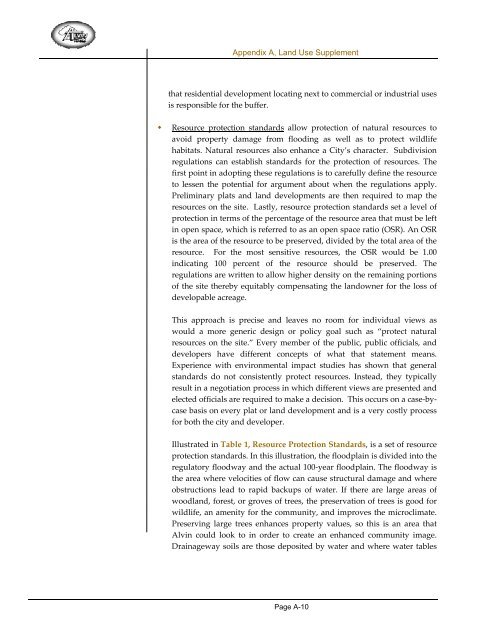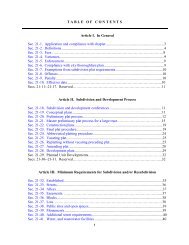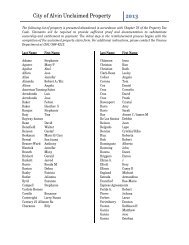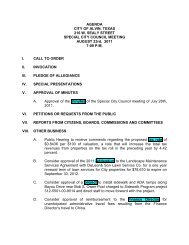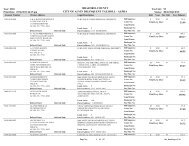Comprehensive Master Plan - City of Alvin
Comprehensive Master Plan - City of Alvin
Comprehensive Master Plan - City of Alvin
- No tags were found...
Create successful ePaper yourself
Turn your PDF publications into a flip-book with our unique Google optimized e-Paper software.
Appendix A, Land Use Supplementthat residential development locating next to commercial or industrial usesis responsible for the buffer.• Resource protection standards allow protection <strong>of</strong> natural resources toavoid property damage from flooding as well as to protect wildlifehabitats. Natural resources also enhance a <strong>City</strong>’s character. Subdivisionregulations can establish standards for the protection <strong>of</strong> resources. Thefirst point in adopting these regulations is to carefully define the resourceto lessen the potential for argument about when the regulations apply.Preliminary plats and land developments are then required to map theresources on the site. Lastly, resource protection standards set a level <strong>of</strong>protection in terms <strong>of</strong> the percentage <strong>of</strong> the resource area that must be leftin open space, which is referred to as an open space ratio (OSR). An OSRis the area <strong>of</strong> the resource to be preserved, divided by the total area <strong>of</strong> theresource. For the most sensitive resources, the OSR would be 1.00indicating 100 percent <strong>of</strong> the resource should be preserved. Theregulations are written to allow higher density on the remaining portions<strong>of</strong> the site thereby equitably compensating the landowner for the loss <strong>of</strong>developable acreage.This approach is precise and leaves no room for individual views aswould a more generic design or policy goal such as “protect naturalresources on the site.” Every member <strong>of</strong> the public, public <strong>of</strong>ficials, anddevelopers have different concepts <strong>of</strong> what that statement means.Experience with environmental impact studies has shown that generalstandards do not consistently protect resources. Instead, they typicallyresult in a negotiation process in which different views are presented andelected <strong>of</strong>ficials are required to make a decision. This occurs on a case‐bycasebasis on every plat or land development and is a very costly processfor both the city and developer.Illustrated in Table 1, Resource Protection Standards, is a set <strong>of</strong> resourceprotection standards. In this illustration, the floodplain is divided into theregulatory floodway and the actual 100‐year floodplain. The floodway isthe area where velocities <strong>of</strong> flow can cause structural damage and whereobstructions lead to rapid backups <strong>of</strong> water. If there are large areas <strong>of</strong>woodland, forest, or groves <strong>of</strong> trees, the preservation <strong>of</strong> trees is good forwildlife, an amenity for the community, and improves the microclimate.Preserving large trees enhances property values, so this is an area that<strong>Alvin</strong> could look to in order to create an enhanced community image.Drainageway soils are those deposited by water and where water tablesPage A-10


